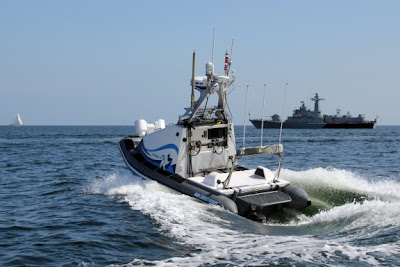Poland's Naval Unmanned Systems Developments
Although the Polish Navy operates a range of remotely operated vehicles today, there is no yet publicly known autonomous vehicle in operation. The situation is quickly changing, though. Three AUV systems planned for mine-hunting use on future patrol ships were mentioned in the Navy's last modernization plan. Additionally, General Skrzypczak, responsible for modernization programs in the Ministry of Defense, recently discussed MoD interest in Unmanned Surface Vessels for port protection and surveillance. These craft are expected to have some limited offensive capability. Not surprisingly, during a visit at this year's Euronaval convention, the Israeli company Rafael introduced the Polish delegation to its latest up-armed version of Protector. Later it was reported that after the exhibition, an agreement for potential technology transfer between companies (not mentioned by name) was signed. It is an important indication of rapid improvements coming in this long neglected area, especially, since some of the ingredients for potential solutions are already in place. As an example, during the 2011 Balt Military Expo, the locally designed USV Edredon was revealed to the public for the first time.
A combined effort of Polish R&D centers and industry, the Edredon is 6 meters long, has a range of about 20 km, an endurance up to 30 hours and the ability to operate in up to sea state 4.
On a related note, the Spike missiles fired recently from the US Navy's Protector USV are in service with Polish Army. Some observers believe that the main obstacle to introducing such an armed unmanned vessel in the Polish Navy is not technology but the organization and division of responsibilities between different government agencies involved in the protection of Polish border, coasts, and harbors. Solving these kinds of conflicts and intersecting areas of interest would require significant cooperation and changes in regulations.
Indeed, it is much easier to change technology than to change institutional habits. On the positive side, such a move could be quite possible for Poland, as having no legacy systems there is no need to struggle with forced evolution toward new solutions. Starting from scratch promises a much quicker road to unmanned systems integration than an evolutionary process.
There is a unique opportunity to make a big step forward in implementing these exciting new tools into Poland's inventory. Such a strategy is linked to another interesting question. Unmanned vehicles are an interdisciplinary technology requiring a developed industrial base in many areas. What is more promising and productive - to attempt local production of "hardware" or to focus on systems integration - from conceptual design, through command and control, down to the hardware?
Indeed, it is much easier to change technology than to change institutional habits. On the positive side, such a move could be quite possible for Poland, as having no legacy systems there is no need to struggle with forced evolution toward new solutions. Starting from scratch promises a much quicker road to unmanned systems integration than an evolutionary process.
There is a unique opportunity to make a big step forward in implementing these exciting new tools into Poland's inventory. Such a strategy is linked to another interesting question. Unmanned vehicles are an interdisciplinary technology requiring a developed industrial base in many areas. What is more promising and productive - to attempt local production of "hardware" or to focus on systems integration - from conceptual design, through command and control, down to the hardware?
Przemyslaw Krajewski writes on Polish Naval Issues at his blog Viribus Unitis.


Comments
Post a Comment